
Hello my fellow steemains i truly enjoy learning more about our universe so i put to together a list of galaxies you need to know
They are billions of Galaxies in our universe, but only one is know to contain life and that's the Milky Way Galaxy, so here is ten of our closest neighbors you probably never heard about.
Andromeda
.jpg)
The Andromeda Galaxy is a spiral galaxy approximately 2.5 million light-years away in the constellation Andromeda. The image also shows Messier Objects 32 and 110, as well as NGC 206 (a bright star cloud in the Andromeda Galaxy) and the star Nu Andromedae. This image was taken using a hydrogen-alpha filter
Black Eye Galaxy
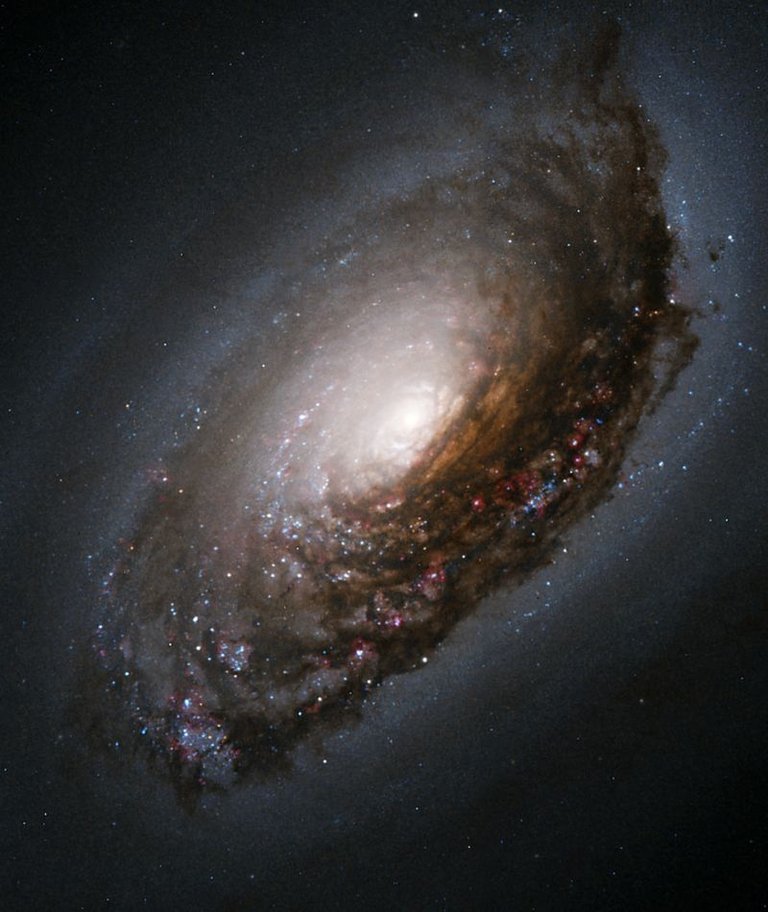
This image of Messier 64 (M64) was taken with Hubble's Wide Field Planetary Camera 2 (WFPC2). The color image is a composite prepared by the Hubble Heritage Team from pictures taken through four different color filters. These filters isolate blue and near-infrared light, along with red light emitted by hydrogen atoms and green light from Strömgren y. M64 has a spectacular dark band of absorbing dust in front of the galaxy's bright nucleus, giving rise to its nicknames of the Black Eye or Evil Eye galaxy. At first glance, M64 appears to be a fairly normal pinwheel-shaped spiral galaxy. As in the majority of galaxies, all of the stars in M64 are rotating in the same direction, clockwise as seen in the Hubble image. However, detailed studies in the 1990's led to the remarkable discovery that the interstellar gas in the outer regions of M64 rotates in the opposite direction from the gas and stars in the inner regions. Active formation of new stars is occurring in the shear region where the oppositely rotating gases collide, are compressed, and contract. Particularly noticeable in the image are hot, blue young stars that have just formed, along with pink clouds of glowing hydrogen gas that fluoresce when exposed to ultraviolet light from newly formed stars. Astronomers believe that the oppositely rotating gas arose when M64 absorbed a satellite galaxy that collided with it, perhaps more than one billion years ago. This small galaxy has now been almost completely destroyed, but signs of the collision persist in the backward motion of gas at the outer edge of M64.
Messier 81
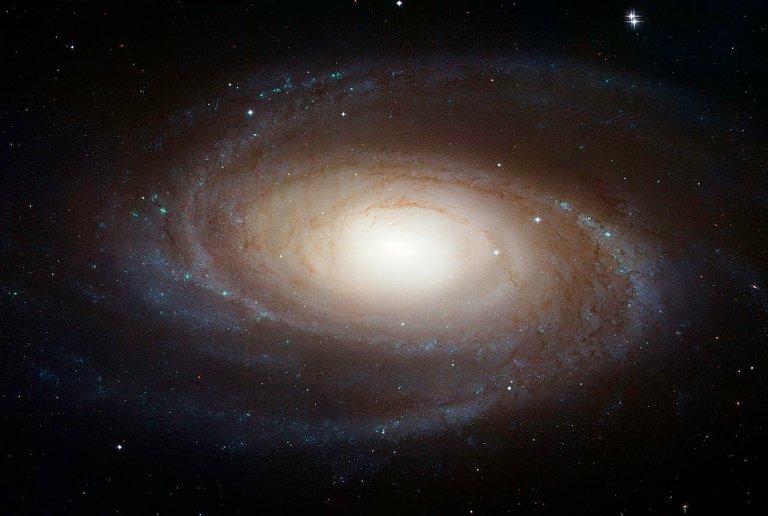
The spiral galaxy Messier 81 is tilted at an oblique angle on to our line of sight, giving a "birds-eye view" of the spiral structure. The galaxy is similar to our Milky Way, but our favorable view provides a better picture of the typical architecture of spiral galaxies. Though the galaxy is 11.6 million light-years away, NASA Hubble Space Telescope's view is so sharp that it can resolve individual stars, along with open star clusters, globular star clusters, and even glowing regions of fluorescent gas
Cartwheel
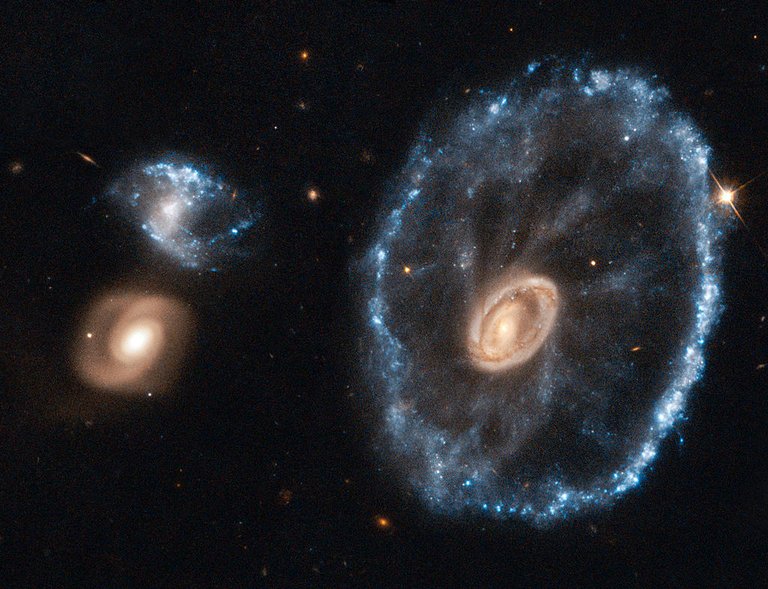
The Cartwheel Galaxy (also known as ESO 350-40) is a lenticular galaxy and ring galaxy about 500 million light-years away in the constellation Sculptor. It is an estimated 150,000 light-years diameter, and a mass of about 2.9–4.8 × 109 solar masses; it rotates at 217 km/s.
It was discovered by Fritz Zwicky in 1941. Zwicky considered his discovery to be "one of the most complicated structures awaiting its explanation on the basis of stellar dynamics.
An estimation of the galaxy's span resulted in a conclusion of 150,000 light years, which is slightly larger than the Milky Way.
The galaxy was once a normal spiral galaxy before it apparently underwent a head-on collision with a smaller companion approximately 200 million years ago (i.e., 200 million years prior to the image). When the nearby galaxy passed through the Cartwheel Galaxy, the force of the collision caused a powerful shock wave through the galaxy, like a rock being tossed into a sandbed. Moving at high speed, the shock wave swept up gas and dust, creating a starburst around the galaxy's center portion that were unscathed. This explains the bluish ring around the center, brighter portion. It can be seen that the galaxy is beginning to retake the form of a normal spiral galaxy, with arms spreading out from a central core.
Alternatively, a model based on the gravitational Jeans instability of both axisymmetric (radial) and nonaxisymmetric (spiral) small-amplitude gravity perturbations allows an association between growing clumps of matter and the gravitationally unstable axisymmetric and nonaxisymmetric waves which take on the appearance of a ring and spokes
Cigar Galaxy
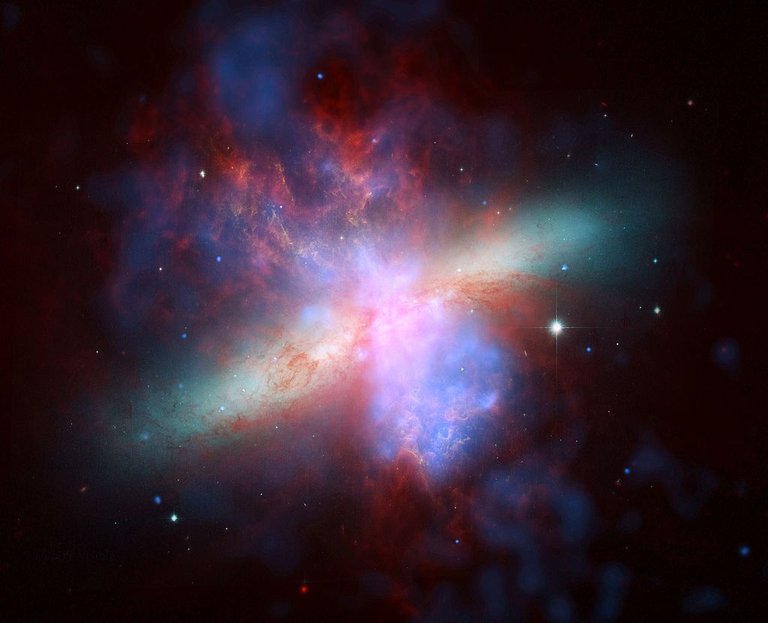
Messier 82 (also known as NGC 3034, Cigar Galaxy or M82) is a starburst galaxy about 12 million light-years away in the constellation Ursa Major. A member of the M81 Group, it is about five times more luminous than the whole Milky Way and has a center one hundred times more luminous than our galaxy's center. The starburst activity is thought to have been triggered by interaction with neighboring galaxy M81. As the closest starburst galaxy to Earth, M82 is the prototypical example of this galaxy type. SN 2014J, a type Ia supernova, was discovered in the galaxy on 21 January 2014. In 2014, in studying M82, scientists discovered the brightest pulsar yet known, designated M82 X-2
Cosmos Redshift 7

Cosmos Redshift 7 (also known as COSMOS Redshift 7, Galaxy Cosmos Redshift 7, Galaxy CR7 or CR7) is a high-redshift Lyman-alpha emitter galaxy (meaning CR7 is one of the oldest, most distant galaxies), in the constellation Sextans, about 12.9 billion light travel distance years from Earth, reported to contain the first stars (first generation; Population III)—formed soon after the Big Bang during the reionisation epoch (redshift, z ∼ 6−7), when the Universe was about 800 million years old—to have provided the chemical elements (like oxygen, nitrogen, carbon, calcium and iron) needed for the later formation of planets and life as it is known
Hoag's Object
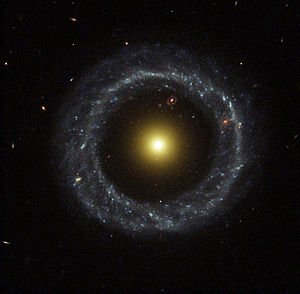
Hoag's Object is a non-typical galaxy of the type known as a ring galaxy. The galaxy is named after Arthur Hoag who discovered it in 1950 and identified it as either a planetary nebula or a peculiar galaxy with eight billion stars.
A nearly perfect ring of young hot blue stars circles the older yellow nucleus of this ring galaxy c. 600 million light-years away in the constellation Serpens. The diameter of the 6 arcsecond inner core of the galaxy is about 17±0.7 kly (5.3±0.2 kpc) while the surrounding ring has an inner 28″ diameter of 75±3 kly (24.8±1.1 kpc) and an outer 45″ diameter of 121±4 kly (39.9±1.7 kpc), which is slightly larger than the Milky Way Galaxy. [a] The gap separating the two stellar populations may contain some star clusters that are almost too faint to see. As rare as this type of galaxy is, another more distant ring galaxy (SDSS J151713.93+213516.8) can be seen through Hoag's Object, between the nucleus and the outer ring of the galaxy, at roughly the one o'clock position in the image shown here. The galaxy spans about 100,000 light years
The Milky Way
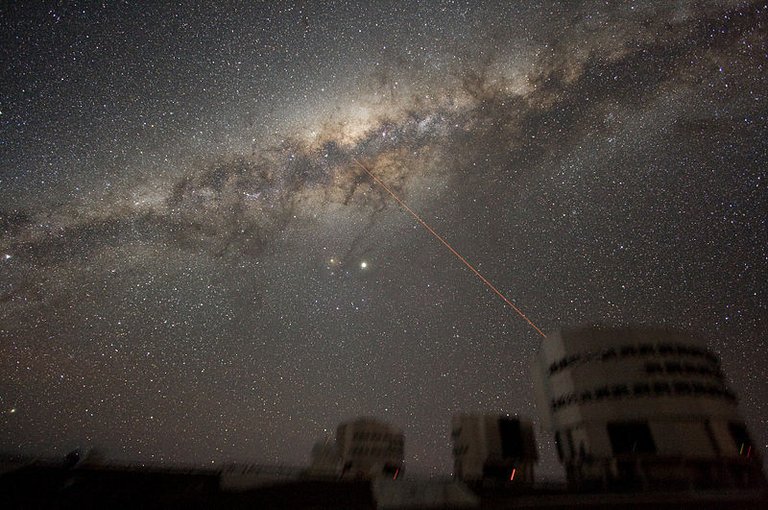
The Milky Way is the galaxy [nb 1] that contains our Solar System. The descriptive "milky" is derived from the appearance from Earth of the galaxy – a band of light seen in the night sky formed from stars that cannot be individually distinguished by the naked eye. The term Milky Way is a translation of the Latin via lactea, from the Greek γαλαξίας κύκλος (galaxías kýklos, "milky circle"). From Earth, the Milky Way appears as a band because its disk-shaped structure is viewed from within. Galileo Galilei first resolved the band of light into individual stars with his telescope in 1610. Until the early 1920s, most astronomers thought that the Milky Way contained all the stars in the Universe.[28] Following the 1920 Great Debate between the astronomers Harlow Shapley and Heber Curtis, observations by Edwin Hubble showed that the Milky Way is just one of many galaxies.
The Milky Way is a barred spiral galaxy with a diameter between 100,000 and 180,000 light-years. The Milky Way is estimated to contain 100–400 billion stars. There are probably at least 100 billion planets in the Milky Way. The Solar System is located within the disk, about 26,000 light-years from the Galactic Center, on the inner edge of one of the spiral-shaped concentrations of gas and dust called the Orion Arm. The stars in the inner ≈10,000 light-years form a bulge and one or more bars that radiate from the bulge. The very center is marked by an intense radio source, named Sagittarius A*, which is likely to be a supermassive black hole.
Stars and gases at a wide range of distances from the Galactic Center orbit at approximately 220 kilometers per second. The constant rotation speed contradicts the laws of Keplerian dynamics and suggests that much of the mass of the Milky Way does not emit or absorb electromagnetic radiation. This mass has been termed "dark matter". The rotational period is about 240 million years at the position of the Sun. The Milky Way as a whole is moving at a velocity of approximately 600 km per second with respect to extragalactic frames of reference. The oldest stars in the Milky Way are nearly as old as the Universe itself and thus probably formed shortly after the Dark Ages of the Big Bang.
The Milky Way has several satellite galaxies and is part of the Local Group of galaxies, which is a component of the Virgo Supercluster, which is itself a component of the Laniakea Supercluster
Sombrero Galaxy
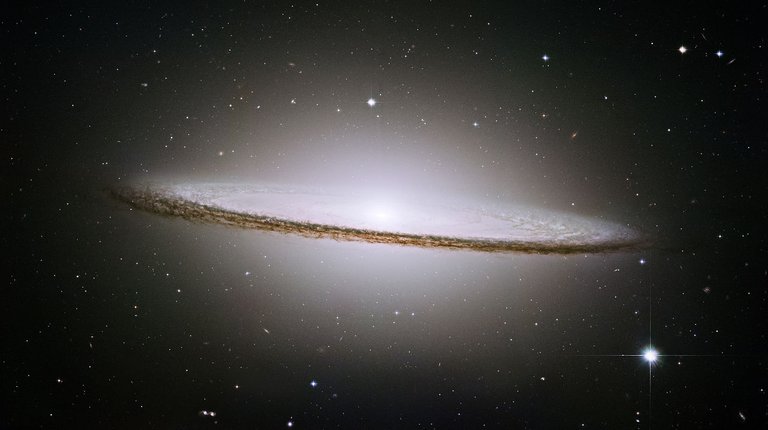
Sombrero Galaxy (also known as Messier Object 104, M104 or NGC 4594) is an unbarred spiral galaxy in the constellation Virgo located 31 million light-years (9.5 Mpc) from Earth. The galaxy has a diameter of approximately 50,000 light-years, 30% the size of the Milky Way. It has a bright nucleus, an unusually large central bulge, and a prominent dust lane in its inclined disk. The dark dust lane and the bulge give this galaxy the appearance of a sombrero. Astronomers initially thought that the halo was small and light, indicative of a spiral galaxy, but Spitzer found that the halo around the Sombrero Galaxy is larger and more massive than previously thought, indicative of a giant elliptical galaxy.[3] The galaxy has an apparent magnitude of +9.0, making it easily visible with amateur telescopes, and it is considered by some authors to be the brightest galaxy within a radius of 10 megaparsecs of the Milky Way. Its large bulge, its central supermassive black hole, and its dust lane all attract the attention of professional astronomers
The Whirlpool Galaxy
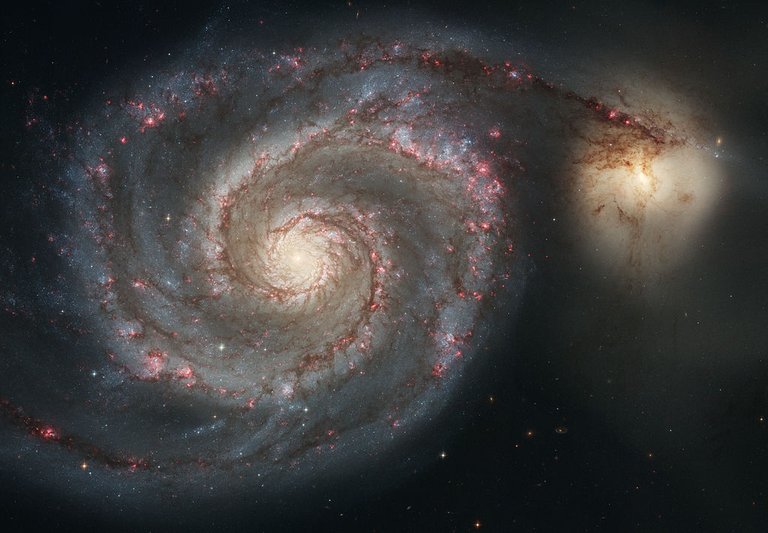
The Whirlpool Galaxy, also known as Messier 51a, M51a, or NGC 5194, is an interacting grand-design spiral galaxy with a Seyfert 2 active galactic nucleus in the constellation Canes Venatici. It was the first galaxy to be classified as a spiral galaxy. Recently it was estimated to be 23 ± 4 million light-years from the Milky Way, but different methods yield distances between 15 and 35 million light-years. Messier 51 is one of the best known galaxies in the sky. The galaxy and its companion, NGC 5195, are easily observed by amateur astronomers, and the two galaxies may even be seen with binoculars. The Whirlpool Galaxy is also a popular target for professional astronomers, who study it to further understand galaxy structure (particularly structure associated with the spiral arms) and galaxy interactions
Source of information
https://en.wikipedia.org/wiki/List_of_galaxies
Thanks for checking out my post @youngjerv
Earn bitcoin from lifetime contract here https://hashflare.io/r/7A4214AD
Discount Code 7A4214AD
Please Follow, Resteem and Upvote please
Thank you so much
cgi af
I am so fascinated about the universe and heavenly bodies! Thanks for sharing this!